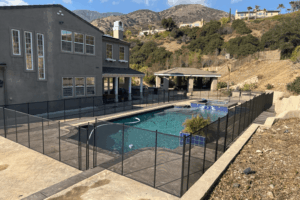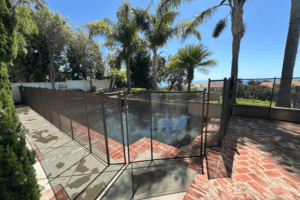
10 Questions to Ask Before Buying a Pool Safety Fence
Don’t buy a pool safety fence without asking these essential questions. This buyer’s guide helps you evaluate height, compliance, materials, installation, and more.

Heating a pool and pool safety go hand in hand. Pools that have a comfortable water temperature are less likely to lead to swimmers in distress, and knowing how to heat a pool without compromising on safety lowers the risk of accidental drowning while waiting for the water to get to that comfortable level. Too many pool owners find themselves cutting corners while waiting for the pool to get just a little bit warmer, or alternatively, decide to forego the use of the pool they’ve worked so hard for because keeping it warm seems financially daunting. As your safe swimming pool experts, we’re ready to help you have a better swimming experience while protecting your friends, family, and pets from tragedy.
The United States Department of Energy recommends a pool temperature of 78-82 degrees for maximum energy savings in the pool, but this range also falls largely in line with safety guidelines from the American Red Cross for general swimming activities, although smaller children and the elderly may require higher temperatures. If the water is too cold, usually below 77 degrees, it can cause immediate muscle spasms and respiratory difficulties, while higher temperatures can cause blood pressure to rapidly drop as your body tries desperately to keep itself cool. Unfortunately, unless you’re lucky enough to live in very specific climate bands, nature doesn’t always cooperate with these needs, leaving indoor and outdoor pools and spas outside this range.
Heating a pool isn’t just for winter use. When you factor in the cooler temperatures of spring and fall as well as unseasonably cooler summer days, most of the year, your pool may need help maintaining a temperature warm enough for comfort. It’s also important to note that–while the recommended guidelines above are important–the body doesn’t just react to static temperatures but also to temperature changes. We’ve all spent time out under the sun on an extremely hot summer day before jumping into a pool and experiencing a temperature shock, as the skin that was acclimated to an air temperature of over 100 degrees is suddenly surrounded by water 30-plus degrees cooler. It can be almost excruciating until our body readjusts. Being able to reliably maintain your water’s heat can help ensure it’s always ready for fun, exercise, or relaxation when you are.
Pool heaters are the most reliable way to add heat to your swimming pool, but, unfortunately, they can also be one of the most cost-prohibitive options. Traditional electric or natural gas heaters and modern pool heat pumps raise the pool’s temperature using the same basic mechanism–water is circulated from the pool into a heating chamber before being returned to disperse that stored heat to the full volume of water. They differ in how the heating chamber is warmed. Traditional heaters create the heat directly, similar to the way home furnaces work. Heat pumps draw in outside air, forcing it over coils filled with liquid coolant, heating the coolant to its boiling point, which then, in turn, is transferred to the water in the heating chamber. Heat pumps are more energy efficient but also face the limitations of the outside air’s ability to store and deliver heat to the condensing coils.
Evaporation not only reduces your water volume and the amount of chemicals in your pool but also lowers its temperature by around five degrees for every ¼” of pool water lost. One of the easiest ways you can keep your pool warm is by preventing the loss of heat with a good pool evaporation cover. Solar covers, rings, and blankets help combat evaporation by covering the pool’s exposed surface. Many designs also incorporate features to trap heat from the sun, passing it into the water underneath.
Another option that not only reduces evaporation but improves safety is installing a swimming pool safety cover. Featuring a strong mesh fabric anchored around the pool’s edge by clips or fixed to rails, these covers are strong enough to support the weight of a full-grown adult, pet, or child who may be too impatient to stay out of the pool without supervision. Easy to use and care for, these covers are effective safety barriers that can prevent your swimming pool from becoming the site of one of the 4,000 lives lost annually to accidental drowning.
A relatively new addition to your arsenal when it comes to heating a pool, liquid covers are pool additives that rise to the surface of the water, creating a thin, evaporation-resistant surface coating. They’re non-toxic, bio-degradable, and safe to swim in, although they don’t provide the protection or thermal assistance safety covers or solar covers do, respectively.
Just as with pool heat pumps, air passing over your pool’s surface creates the opportunity for thermal energy to transfer, but this time it will be the heat from your pool radiating out into the air. Installing a taller fence around your pool can help provide a windbreak to provide partial shelter from air currents while also improving pool safety. Removable mesh pool fences use a rip-stop mesh material stretched between strong poles to create a climb-resistant barrier up to five feet tall around your swimming pool area. Secured by a self-closing and latching gate, it helps prevent unauthorized access and gives you some surface wind protection without blocking your view or making your pool area feel closed in.
If you’re feeling crafty, one popular hack for heating a pool may be right up your alley. You’ll need a length of black irrigation hose and a small electric sump pump, commonly available for $250 or less. The sump pump draws water up from the pool and passes it through the black irrigation hose coiled in the sun before returning it back into the pool. The sun heats the water in the coiled hose, turning it into a solar heating system that works on the same principles as the traditional heaters and heat pumps mentioned above.
However you choose to heat a pool, make sure you’re keeping the pool safe. Your pool should never be unsecured when a responsible, competent adult swimmer isn’t around to supervise activities, and no pool heating apparatus should be positioned where it can become a tripping hazard or aid a child or pet in climbing over your pool fence. That means keeping the gate secured, hoses out of reach, and pool accessories either inside the fence or stored properly where they can’t be accessed.
When you schedule a free quote, your local independent All-Safe Pool installer will talk to you about your pool needs, take measurements, and offer you a written quote that lays out your pool protection options to make maintaining, using, and heating your pool safer. There’s no cost or obligation to find out how cost-effective peace of mind can be. Request your custom pool safety estimate from your All-Safe Pool pro today.

Don’t buy a pool safety fence without asking these essential questions. This buyer’s guide helps you evaluate height, compliance, materials, installation, and more.

Understand how local pool fence codes work and what to check before installation. This beginner’s guide simplifies requirements so your safety barrier complies and protects effectively.

Learn the truth behind common pool safety myths and make better decisions to protect your family with fact‑based guidance on fences, barriers, and maintenance.
Enter your zip code to locate an independent installer in your area
Enter your zip code to locate an independent installer in your area

Due to the many variations in monitors, phones, and browsers, color samples and product examples may appear different on different screens. Computers and mobile devices are not all calibrated equally and color reproduction on the Internet is not precise. The same is true for printed items such as brochures and other sales literature.
In addition, the colors of our products photograph differently under different lighting conditions. For example, photos taken in full sunlight will vary from photos taken on a cloudy or overcast day. Similarly, shadows from nearby objects can affect the color and transparency of our products. If a precise color or specific shade is important, please inspect the actual color of your product prior to installation.
Many of our products’ materials are not available through typical stores and vendors and therefore must be custom manufactured specifically for our use. In order to control costs and provide you with the best value possible, our raw materials are produced in large batches and can often take several months to receive. The colors of our materials can, and often do, vary slightly from batch to batch. Although we make every effort to minimize color variations, we cannot be responsible for these differences when they occur. If a precise color or specific shade is important, please inspect the actual color of your product prior to installation.
For example, we use the name “putty” to describe some of our products. Your idea of the color “putty” may be different than someone else’s idea of “putty”. In addition, products may have the same color name but may not be the exact same color. For example, we have different shades of “black”. Please do not order using color names as your only guide. If a precise color or specific shade is important, please inspect the actual color of your product prior to installation.
If it is important that your product be an exact color or shade, it is highly recommended that you inspect the actual product prior to its installation and address any concerns with your local independent installer. Most independent installers do not offer refunds or accept returns due to color variations.